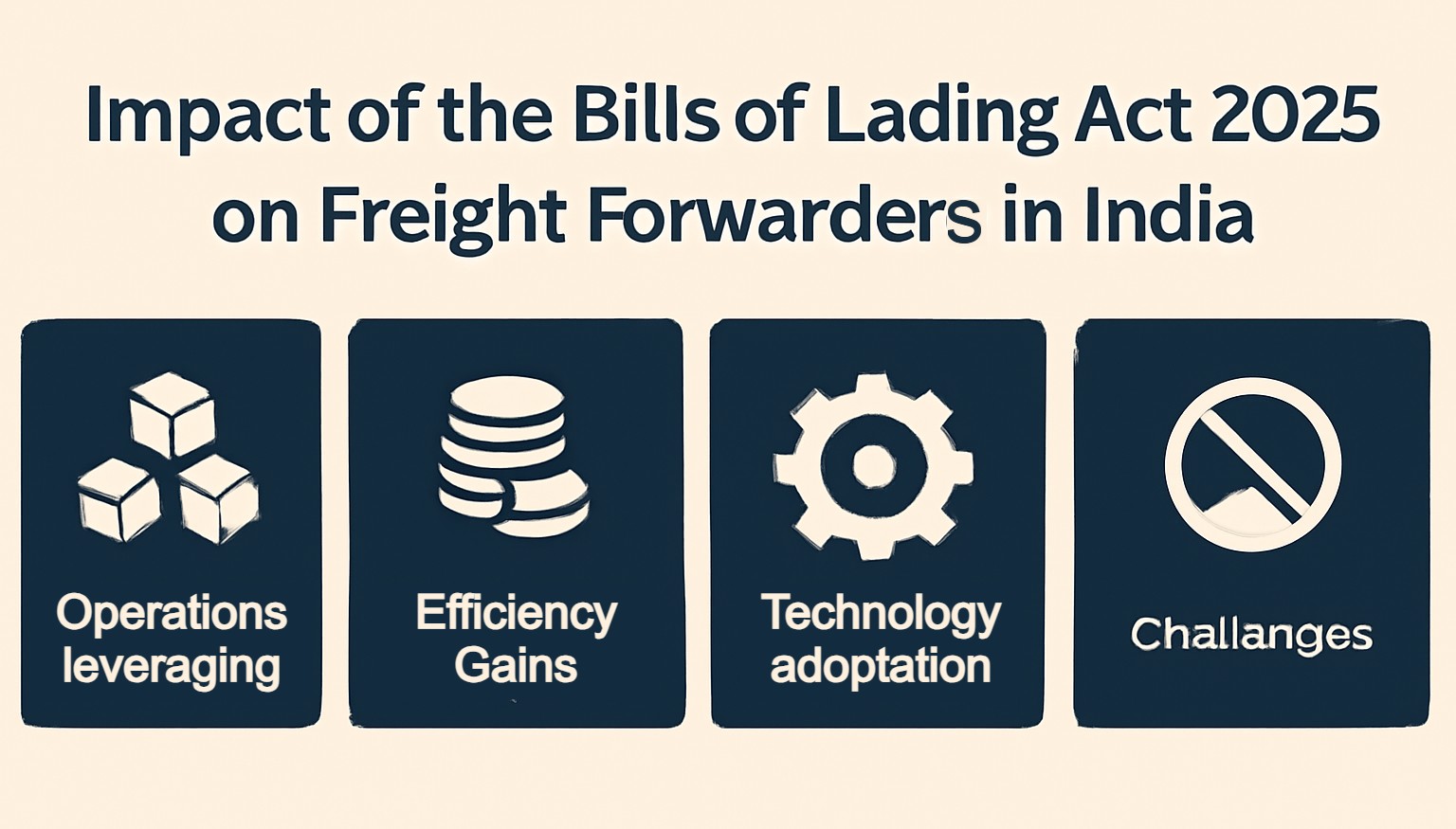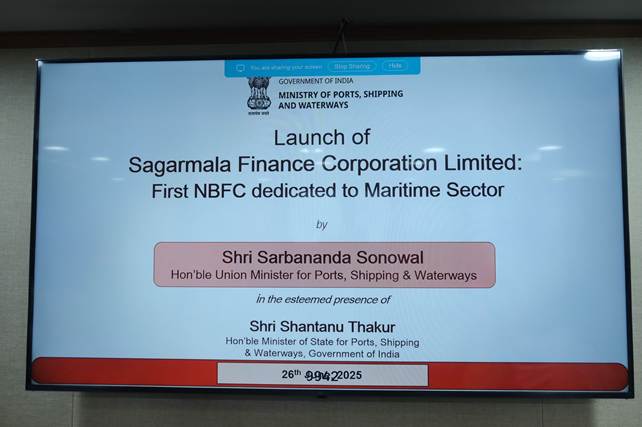Maritime News India ; The Bills of Lading Act 2025 fundamentally accelerates digital transformation of India’s freight-forwarding sector. While freight forwarders face substantial upfront investments and skill-gaps, early eBL ( Electronic Bill of Lading ) adopters will realize 30–40% efficiency gains, unlock new advisory revenues, and capture market share—whereas laggards risk 10–15% margin erosion and loss of competitiveness.
1. Freight-Forwarding in India: Market Overview
In FY 2024, India’s freight-forwarding market was valued at USD 10.1 billion, and is projected to grow at a CAGR of 10.9% to reach USD 17 billion by FY 20291. Despite this expansion, the sector remains paper-intensive, with only 29.4% of freight-forwarding respondents reporting any eBL use in 2024—well below the overall industry adoption rate of 49.2%2.
| Metric | FY 2024 Value | FY 2029 Projection | CAGR FY 24–29 |
|---|---|---|---|
| Indian Freight-Forwarding Market (USD) | 10.1 billion1 | 17.0 billion1 | 10.9% |
| eBL Adoption (Freight Forwarders) | 29.4%2 | — | — |
| eBL Overall Industry Adoption | 49.2%2 | 50% target by 2030 | — |
2. Operational Efficiency and Cost Savings
2.1 Throughput and Error Reduction
- Processing Time: eBL issuance reduces documentation time from 48–72 hours (paper) to under 2 hours, boosting throughput by 30–40% and cutting manual-entry errors by 85%2.
- Cost Savings: Eliminating printing, courier, and data-entry cuts per-BL costs by USD 65–75, yielding potential industry-wide savings of USD 2 billion annually if eBL adoption reaches 50% by 20303.
2.2 Case Study: MSC–WAVE Pilot
MSC’s WAVE-powered eBL pilot in India processed hundreds of thousands of eBLs since 2021, cutting average turnaround from 4.2 days to 3 hours and avoiding USD 138,000 in demurrage on 230 TEUs4.
3. New Revenue Streams and Value-Added Services
- End-to-End Visibility: Integration with TMS/ERP platforms enables freight forwarders to offer real-time shipment tracking, predictive ETA analytics, and automated exception management.
- Trade-Finance Facilitation: eBL’s legal certainty accelerates letter-of-credit negotiations, reducing LC cycle times by 5–7 days and lowering discounting costs by 20–25 basis points.
- Consulting Services: As paperwork becomes commoditized, freight forwarders can pivot to advisory—covering customs optimization, risk management, and digital-trade compliance.
4. Technology and Investment Requirements
| Investment Area | Small Operators | Large Operators | ROI Horizon |
|---|---|---|---|
| eBL Platform Subscription | USD 10–20 k/yr | USD 50–100 k/yr | 12–18 months |
| API Integration & Cybersecurity | USD 5–15 k one-time | USD 30–50 k one-time | 6–12 months |
| Staff Training & Certification | USD 8–15 k/yr | USD 30–50 k/yr | Immediate–6 mo |
Smaller forwarders need government-backed low-interest loans or grants to bridge the 150–200% surge in technology and training costs5.
5. Adoption Barriers and Solutions
5.1 Barriers
- Platform Fragmentation: Multiple eBL solutions impede interoperability, discouraging adoption3.
- Stakeholder Readiness: Only 64.7% freight-forwarder awareness and 29.4% adoption highlight need for education2.
- Regulatory Uncertainty: Ambiguity around eBL’s status as title document persists in some jurisdictions5.
5.2 Mitigation Strategies
- Standards Compliance: Adopt DCSA’s PINT API and Control Tracking Registry to ensure cross-platform eBL interoperability3.
- Industry Collaboration: Join FIT Alliance and FIATA initiatives to share best practices and support unified rollout26.
- Government Support: Leverage Sagarmala digital-trade sandboxes, subsidized training, and phased eBL mandates for major ports.
6. ESG and Risk Management
- Environmental: Transition to eBL could eliminate ~615,000 tCO₂e annually by reducing paper use and courier flights2.
- Governance: Blockchain-anchored eBLs provide immutable audit trails, reducing duplicate-document fraud by 15–20% and litigation risk by 30%35.
- Social: Digital workflows reduce manual handling injuries and upskill workers into higher-value IT and analytics roles.
7. Policy Recommendations
- Incentivize eBL Pilots: Government-funded grants for freight forwarders partnering with carriers to test eBL workflows.
- Phased Mandates: Require 25% eBL usage at JNPT, Mundra, and Chennai by 2027, scaling to 60% by 2029.
- Accredited Training Programs: Collaborate with FIATA and industry bodies to certify 5,000 freight-forwarder staff in eBL standards by 2026.
- Interoperability Council: Establish a multi-stakeholder body to certify eBL platforms against DCSA and FIATA standards.
Conclusion
The Bills of Lading Act 2025 compels India’s freight-forwarders to transition from document processors into strategic digital-trade facilitators. Those who invest in interoperable eBL platforms, staff upskilling, and collaborative standards adoption will secure market leadership, diversify revenues, and support India’s vision of a paperless, efficient maritime supply chain. Freight-forwarders must digitize—or risk obsolescence in an increasingly competitive global trade environment.
- https://www.glottislogistics.in/pdf/Industry-report.pdf
- https://dst.news/news/fit-alliances-2024-ebl-survey-shows-steady-rise-of-electronic-bill-of-lading-adoption-globally/
- https://www.porttechnology.org/news/dcsa-completes-standards-based-interoperable-ebl-transaction/
- https://www.shippingandfreightresource.com/msc-accelerates-adoption-of-electronic-bill-of-lading-ebl-in-india-with-wave/
- https://mfame.guru/dcsa-overcoming-legal-and-regulatory-barriers-to-ebl-adoption/
- https://indianinfrastructure.com/2022/08/20/fiata-bill-of-lading-launched/
- https://www.lawjournals.net/assets/archives/2023/vol5issue1/5009-872.pdf
- https://cargox.io/fiata-bill-of-lading
- https://dcsa.org/newsroom/overcoming-legal-and-regulatory-barriers-to-ebl-adoption
- https://www.maritimegateway.com/honble-minister-of-ports-shipping-and-waterways-shri-sarbananda-sonowal-launches-fiata-bill-of-lading-in-india-at-fffai-convention/
- https://www.porttechnology.org/news/dcsa-enters-final-phase-of-ebl-platform-interoperability-poc/
- https://www.youtube.com/watch?v=EsDqMsXae1s
- https://fiata.org/n/fit-alliances-2024-ebl-survey-shows-steady-rise-of-electronic-bill-of-lading-adoption-globally-collaboration-across-trade-supply-chain-could-unlock-further-gains/
- https://www.itln.in/shipping/dcsa-begins-final-phase-of-ebl-interoperability-proof-of-concept-1345927
- https://fiata.org/projects/
- https://payloadasia.com/2023/07/indias-forwarders-tap-kale-to-adopt-e-fbl-solution/
- https://indiashippingnews.com/dcsa-shipping-lines-to-adopt-100-ebl-by-2030/
- https://www.cargowise.com/news/introducing-the-new-electronic-fiata-bill-of-lading-in-cargowise/
- https://www.ajot.com/news/fit-alliances-2024-ebl-survey-shows-steady-rise-of-electronic-bill-of-lading-adoption-globally-collaboration-across-trade-supply-chain-could-unlock-further-gains
- https://trans.info/en/ebl-platform-dcsa-296324




